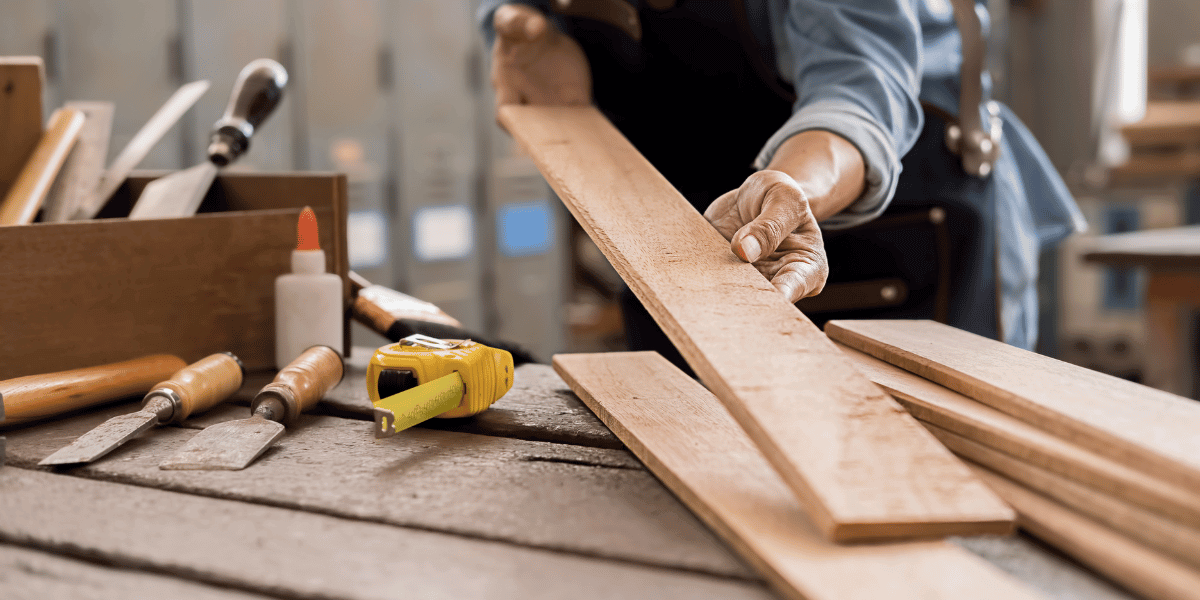Working as a carpenter is a rewarding career that needs both technical knowledge and practical skills. Carpenters are key in the construction world, creating wooden structures that are the heart of our buildings. Knowing what a carpenter does is crucial for those thinking about this career. The job can involve many things, from building homes to commercial buildings, with many specialisations to choose from.
We will look at the skills needed to be successful in carpentry, the training and qualifications required, and the tools and equipment used. By covering these points, we aim to give a full picture for anyone interested in a carpentry career.
Understanding the Role of a Carpenter
The carpenter role is key in the construction world. They cut, shape, and install materials like wood. Carpenters do many tasks, from designing structures to adding finishing touches. Their skills are crucial for both looks and function in buildings.
Definition and Scope of Work
Carpenters do a lot of work. They build frames, put on siding, and make detailed millwork. Their work is seen in homes, offices, and factories. Each project needs different skills, showing carpentry’s wide range.
Types of Carpentry
There are many carpentry types. Framing focuses on building strength. Cabinetry combines function and design in kitchens and bathrooms. Finish carpentry adds beauty to spaces. Each type needs special skills, letting carpenters meet different client needs.
Importance of Carpenters in Construction
Carpenters are very important. Their work makes buildings safe and strong. They also add beauty to spaces. Without them, buildings wouldn’t be as good-looking or sturdy.
Essential Skills and Qualities for a Carpenter
Carpenters need a wide range of skills to do well. They must have both technical and soft skills. These skills are key for anyone wanting to be a carpenter.
Technical Skills Required
Technical skills in carpentry include measuring, cutting, and using woodworking techniques. Carpenters need to be good with hand tools like saws and hammers. They also need to know how to use power tools like drills and sanders.
Knowing building codes and safety rules is crucial. It makes sure projects are done right and safely. Being precise with measurements and cuts is also important. It shows a carpenter’s skill and quality of work.
Soft Skills for Success
Soft skills are just as important for carpenters. Being able to solve problems helps them deal with unexpected issues. Good communication skills help them work well with others. This includes team members and clients.
Working well in a team is key. Carpenters often work with other tradespeople. Managing time well helps meet deadlines and keep projects on track. These soft skills improve work relationships and job happiness.
| Skill Type | Description |
|---|---|
| Technical Skills | Measuring, cutting, using hand and power tools, understanding building codes |
| Soft Skills | Problem-solving, communication, teamwork, time management |
Training and Qualifications for Aspiring Carpenters
To become a skilled carpenter, you need a strong base in carpentry training. It’s important to know the different ways to get the right carpentry qualifications. There are many educational paths that can teach you the skills needed for a successful career in carpentry.
Education Pathways
Most start with Year 10, as it’s often needed for further study. You can get trade qualifications through TAFE or vocational courses. These programs teach both theory and practical skills, getting you ready for the job market.
Apprenticeships and On-the-Job Training
Australian carpentry apprenticeships are key for learning practical skills. They offer hands-on training with experienced professionals. This mix of classroom learning and on-the-job experience is essential for starting a career in carpentry.
Certifications and Licences in Australia
In Australia, you need certain certifications and licences to work as a carpenter. Bodies like the Master Builders Association (MBA) and the Housing Industry Association (HIA) provide these. Getting certified shows you’re committed to your craft and meet industry standards. It also makes you more employable.
Tools and Equipment used by Carpenters
Carpenters need a range of tools and equipment to do their job well. Knowing about different carpentry tools is key to quality work. This part covers hand tools, power tools, and safety gear, all vital for carpenters.
Hand Tools
Hand tools are crucial for detailed carpentry work. Chisels help shape and join wood, while saws make clean cuts. Measuring tapes ensure accuracy, keeping all measurements right. These tools are essential for top-notch craftsmanship.
Power Tools
Power tools make carpenters more efficient and effective. Drills and nail guns speed up assembly, and circular saws make cutting easier. These tools save time and reduce strain, letting carpenters focus on finer details.
Safety Gear and Best Practices
Safety gear is vital for a safe work environment. Helmets, gloves, and goggles protect against site hazards. Following best practices, like handling tools right and keeping them in good shape, also lowers risks. Safety first means better work and health for carpenters.
Conclusion
The carpentry profession is key to the building and construction world. It shows how important skilled carpenters are in making safe and lasting structures. A carpentry career summary offers a path full of chances to be creative and use practical skills.
It requires both technical skills, like knowing tools and materials, and soft skills, like solving problems and talking well. This gives a full view of what it takes to be a carpenter.
For those wanting to become carpenters, there are many ways to start. You can go through education, apprenticeships, or get the right certifications. Each way has its own benefits, whether you like getting your hands dirty or learning in a classroom.
The construction world is always changing, with new tech and designs coming up. This means carpentry’s future looks bright and exciting.
As building methods keep changing, carpenters need to stay open to new ways of working. They can do well in a field that values both old skills and new tech. This makes carpentry a vital part of the industry for many years.


